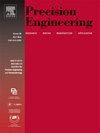Sensitivity study of parameters in a hybrid electrochemical-mechanical polishing process for 316L stainless steel
IF 3.5
2区 工程技术
Q2 ENGINEERING, MANUFACTURING
Precision Engineering-Journal of the International Societies for Precision Engineering and Nanotechnology
Pub Date : 2025-01-10
DOI:10.1016/j.precisioneng.2025.01.007
引用次数: 0
Abstract
The PEMEC process is a new polishing process designed for complex metal parts with high surface roughness. This new hybrid process has been developed by simultaneously coupling tribofinishing and electrochemical polishing. The PEMEC process improves surface roughness in just a few minutes, while preserving edge shape, and is based on a strong synergistic effect between abrasive and chemical mechanisms. To better understand this synergy, it is essential to know which parameters have the greatest influence on polishing results. To this end, it was decided to study the most influential parameters of the two processes combined in PEMEC: drag speed (tribofinishing) as well as temperature and voltage (electropolishing).
This article focusses on the influence of each of these parameters on the PEMEC process, using a multi-scale analysis that simultaneously considers surface roughness, edge geometry, and sample dimensions. For each of the three parameters, the various observable impacts on the sample are described and quantified. Analysis of the results showed that temperature and voltage have a considerable impact on the PEMEC process and are able to modify the mechanisms of the process, as well as material removal rate. In comparison, drag speed has a smaller influence on the process.
求助全文
约1分钟内获得全文
求助全文
来源期刊
CiteScore
7.40
自引率
5.60%
发文量
177
审稿时长
46 days
期刊介绍:
Precision Engineering - Journal of the International Societies for Precision Engineering and Nanotechnology is devoted to the multidisciplinary study and practice of high accuracy engineering, metrology, and manufacturing. The journal takes an integrated approach to all subjects related to research, design, manufacture, performance validation, and application of high precision machines, instruments, and components, including fundamental and applied research and development in manufacturing processes, fabrication technology, and advanced measurement science. The scope includes precision-engineered systems and supporting metrology over the full range of length scales, from atom-based nanotechnology and advanced lithographic technology to large-scale systems, including optical and radio telescopes and macrometrology.

 求助内容:
求助内容: 应助结果提醒方式:
应助结果提醒方式:


